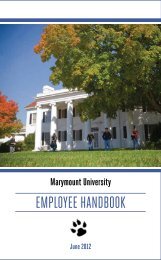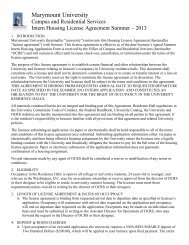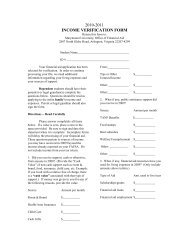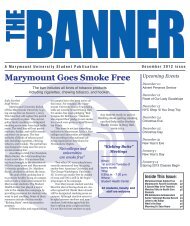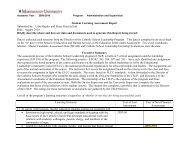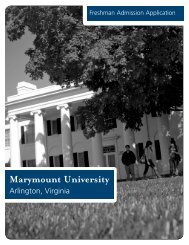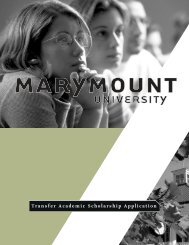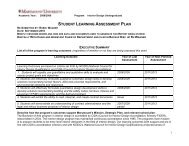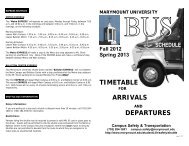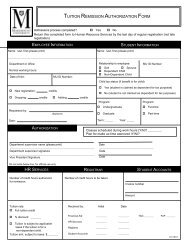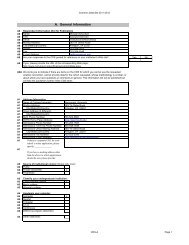student learning assessment report - Marymount University!
student learning assessment report - Marymount University!
student learning assessment report - Marymount University!
You also want an ePaper? Increase the reach of your titles
YUMPU automatically turns print PDFs into web optimized ePapers that Google loves.
Academic Year : 2009-2010 Program: BS Information Technology (IT)<br />
STUDENT LEARNING ASSESSMENT REPORT<br />
SUBMITTED BY: DIANE MURPHY<br />
DATE: OCTOBER 4, 2010<br />
BRIEFLY DESCRIBE WHERE AND HOW ARE DATA AND DOCUMENTS USED TO GENERATE THIS REPORT BEING STORED:<br />
BLACKBOARD COURSES FOR ACADEMIC YEAR 2009-2010<br />
FILING CABINET IN BALLSTON ROOM 311B<br />
List all of the program’s <strong>learning</strong> outcomes:<br />
EXECUTIVE SUMMARY<br />
Almost every major challenge in the world today is turning to information technology for a solution, from conquering disease to<br />
running a large business, from improving education and healthcare, to running a government agency. <strong>Marymount</strong>’s BS in Information<br />
Technology program combines a solid foundation of knowledge across the computer systems life cycle, from requirements definition<br />
to managing a production computer system, and includes courses covering hardware, software, databases, networks, software<br />
testing, project management, and security.<br />
Students have the ability to focus in one of six concentration areas:<br />
• Applied IT for <strong>student</strong>s who wish to use their IT knowledge in a specific field of application such as biology or education.<br />
• Computer Science for <strong>student</strong>s who wish a career designing and building software products or designing, building, and securing<br />
complex networks.<br />
• Forensic Computing for <strong>student</strong>s who wish to specialize in this new and growing field, investigating computer crimes, and<br />
preparing evidence for use in a court of law.<br />
• Health IT for <strong>student</strong>s who wish a career in the emerging field of electronic medical records and other uses of IT to improve<br />
health care<br />
• Information Systems for <strong>student</strong>s who will administer computer networks, provide technical support to system users, and design<br />
and manage Web sites, usually in a business context<br />
• Interactive media for <strong>student</strong>s who wish to work in the creative arts field or specialize in the use of multi-media on the Web..<br />
1
Academic Year : 2009-2010 Program: BS Information Technology (IT)<br />
Learning Outcome<br />
1. Build a broad knowledge of information technology, allowing <strong>student</strong>s to<br />
function as IT professionals that can successfully analyze problems and<br />
implement IT solutions to these problems both in an internship and in a<br />
job after graduation.<br />
2. Build specific skills in a segment of the information technology field<br />
(such as software testing) allowing <strong>student</strong>s to compete successfully for<br />
internships and entry level jobs and to work effectively in these areas.<br />
3. Become proficient in at least one programming language, but be able to learn<br />
additional programming languages based on a knowledge of programming<br />
principles, and participate in programming competitions.<br />
4. Become proficient in a variety of skills such as computer repair, computer<br />
networking, database design, and information security through a combination<br />
of theoretical knowledge and hands-on experience sufficient to obtain industry<br />
certifications.<br />
5. Conduct a capstone project that includes research in an aspect of information<br />
technology (hardware, software, data, or information security) and apply that<br />
research to a current information technology concern for businesses or society<br />
in general.<br />
6. Compose and construct written documents and give presentations articulating<br />
business needs, identifying solutions, and considering decision implications,<br />
with arguments backed up by data.<br />
7. Work successfully in a team environment both as a team leader and as a<br />
participant of a team, and communicate effectively with team members who<br />
do not have a technical background.<br />
8. Conduct themselves as responsible professionals and global citizens<br />
who are aware of ethical issues and societal needs and who can<br />
determine the most ethically response to common ethical dilemmas in<br />
the field<br />
9. Possess the knowledge and skills required to pursue life-long <strong>learning</strong>,<br />
including advanced degrees in areas relating to information technology and to<br />
adapt to an ever-changing, global technological and business environment.<br />
Year of Last Year of Next Planned<br />
Assessment Assessment<br />
2009-2010 2011-2012<br />
2009-2010 2013-2014<br />
2007-2008<br />
2008-2009<br />
2007-2008<br />
2008-2009<br />
2012-2013<br />
2012-2013<br />
2010-2011<br />
2013-2014<br />
2007-2008 2010-2011<br />
2008-2009 2012-2013<br />
2009-2010 2011-2012<br />
2010-2011<br />
2012-2013<br />
2
Academic Year : 2009-2010 Program: BS Information Technology (IT)<br />
Describe how the program’s outcomes support <strong>Marymount</strong>’s Mission, Strategic Plan, and relevant school plan:<br />
The BS in Information Technology program is fully compliant with the mission of <strong>Marymount</strong> <strong>University</strong> and the outcomes include<br />
both the foundation in arts and sciences (needed for a well-rounded education) and career preparation (broad IT knowledge,<br />
specialized knowledge, and specific skills proficiency leading to certifications). It recognizes the new job skills required in the<br />
profession and offers specialized courses (e.g., software testing, health information systems) to increase each <strong>student</strong>'s success in<br />
getting a good internship and/or first job. These job skills are matched with current industry certifications such as A+ and Security+<br />
from CompTIA, and the Certified Software Tester (CSTE) from the QAI Global Institute. The program also includes skills that are<br />
commonly requested by today’s employers (communication skills and the ability to work in teams). Finally, it recognizes the changing<br />
nature of the IT field and hence the need for life-long <strong>learning</strong>. The Applied IT concentration recognizes that the application of IT<br />
covers a wide range of disciplines and can be instrumental in everything from healthcare to education and provides opportunities for<br />
<strong>student</strong>s to apply IT to another field, such as biology..<br />
In compliance with the “<strong>student</strong>s come first” culture at <strong>Marymount</strong>, the program outcomes also reflect the needs of today’s IT<br />
<strong>student</strong>s to have hands-on training to enable them to obtain industry certifications, vital to getting good jobs in the IT field.<br />
Two of the university’s strategic plan goals are reflected in the program <strong>assessment</strong> outcomes:<br />
• “Academic success: Enhance <strong>Marymount</strong>’s mission of excellence in Catholic higher education through a compelling<br />
academic vision that emphasizes intellectual rigor; outstanding instruction; state-of-the-art facilities, technology, and <strong>learning</strong><br />
resources; and strong academic support services.” The BS in Information Technology program is rigorous with outstanding<br />
instruction that will be measured during outcomes <strong>assessment</strong> by the success of our <strong>student</strong>s in a variety of general and<br />
specific technologies including programming, computer repair, computer networks, databases, software testing, and<br />
information security.<br />
• “Student life: Build an exceptional sense of campus community and provide an environment that stimulates and supports<br />
each <strong>student</strong>’s intellectual, moral, spiritual, cultural, and physical growth.” The BS in Information Technology program enables<br />
<strong>student</strong>s to participate in a variety of community events such as the ACM programming competition and School of Business<br />
activities that builds on the sense of campus community. The IT program emphasizes “real projects for real clients” and<br />
involves the university and local communities in its activities.<br />
The School of Business Administration (SBA) Strategic Action Plan emphasizes activities that support the <strong>University</strong>’s strategic<br />
plan. The ability for <strong>student</strong>s to pursue the 5-year BS/MS in Information technology and continue their <strong>learning</strong> programs is one of<br />
the initiatives included in the plan. Another initiative is “to expand ethics considerations in the syllabi” which is reflected as an<br />
outcome measure in this <strong>assessment</strong>.<br />
3
Academic Year : 2009-2010 Program: BS Information Technology (IT)<br />
Provide a brief description of the <strong>assessment</strong> process used including strengths, challenges and planned improvements:<br />
This is the third year of the program and several transfer <strong>student</strong>s have graduated in the last two years. Some changes were made<br />
this year to reflect changes in the IT industry including the rise of IT in health care, the increased use of interactive media, and the<br />
new field of software quality assurance.<br />
Students will be evaluated on their competence to work in the regional IT industry, including both government and commercial<br />
settings. This includes looking at <strong>student</strong>s’ ability to complete an internship and to obtain a meaningful job in the field. In addition, a<br />
project, typical of work in the workplace is used to available the technical performance of each <strong>student</strong>. The standard of 70% was<br />
used for this outcome and all factors measured were met. However, programming proficiency, and its reliance on critical thinking still<br />
maintains difficult for several <strong>student</strong>s.<br />
The second <strong>learning</strong> outcome related to the need for <strong>student</strong>s to acquire skills which are marketable in an ever changing field. The<br />
area selected was software testing (quality assurance), a field selected by the IT Advisory Board as germane to today's IT<br />
workplace.. The new course (IT355) was offered for the first time in Spring 2010 and was used as the focus of this outcome.<br />
Students did not meet the standard for their requirements documentation in their junior year. As this is a precursor to their internship,<br />
this needs to be addressed to ensure their success in the workplace.<br />
The third <strong>learning</strong> outcome assessed related to ethics, a kingpin of education at the School of Business Administration at <strong>Marymount</strong><br />
<strong>University</strong>. The outcome was measured in MSC345, Project Management, as this course discusses the decision-making process.<br />
Students, for the most part, made good ethical decisions but were often unable to articulate the reasons behind their decision.<br />
Further emphasis will be placed on ethics in earlier IT courses (IT110 and IT210) and the course PH305, Business Ethics, will be<br />
made a prerequisite to MSC345. The increased focus on writing throughout the program should also assist in this process.<br />
Three sources of information were used for all three outcomes: a classroom exercise corresponding to each outcome, the Internship<br />
Program Semester Reports from Fall 2009 and Spring 2010 prepared by David Pomeroy, SBA Director of Business Learning, and<br />
the Graduating Student Survey conducted by the Office of Institutional Effectiveness..<br />
Describe how the program implemented its planned improvements from last year:<br />
The department developed seminars for the sophomore, junior and senior level and these will run in Fall 2010 when <strong>student</strong>s will be<br />
first required to take them based on the revised degree plan. Working with its advisory group, the department examined each of the<br />
courses in the program and their relevance to entry level jobs. Software testing was identified as a key area and is included n this<br />
year's evaluation.<br />
4
Academic Year : 2009-2010 Program: BS Information Technology (IT)<br />
The department obtained approval for its Inquiry-based <strong>learning</strong> courses and for its writing intensive courses. In addition, the<br />
introductory IT class (IT110) was revised and approved as a global course. The teaching of these courses will begin in this revised<br />
format in Fall 2010.<br />
Provide a response to last year’s <strong>University</strong> Assessment Committee review of the program’s <strong>learning</strong> <strong>assessment</strong> <strong>report</strong>:<br />
The main comment from the Assessment Committee was that many of the outcomes were not <strong>learning</strong> outcomes. The outcomes<br />
have been rewritten to include more "action" words.<br />
5
Academic Year : 2009-2010 Program: BS Information Technology (IT)<br />
Outcome and Past Assessment<br />
Learning Outcome 1: Build a broad knowledge of information technology, allowing <strong>student</strong>s to function as IT professionals<br />
that can successfully analyze problems and implement IT solutions to these problems both in an internship and in a job<br />
after graduation.<br />
Is this outcome being reexamined? No<br />
Assessment Activity<br />
Outcome Measures<br />
Explain how <strong>student</strong><br />
<strong>learning</strong> will be<br />
measured and indicate<br />
whether it is direct or<br />
indirect.<br />
Direct: Ability of <strong>student</strong><br />
to effectively complete an<br />
internship in the field.<br />
Indirect: Ability of the<br />
<strong>student</strong>s to find a job and<br />
succeed in that job<br />
Performance Standard<br />
Define and explain<br />
acceptable level of<br />
<strong>student</strong> performance.<br />
All IT <strong>student</strong>s must<br />
complete an internship (6<br />
credits) in the IT field or<br />
show evidence of<br />
experience in the field to<br />
receive a waiver of the<br />
internship requirement.<br />
70% of these <strong>student</strong>s<br />
must receive a positive<br />
rating from their<br />
internship supervisor in<br />
all areas of their<br />
performance.<br />
Getting a job is an<br />
important outcome for a<br />
career-oriented program,<br />
particularly in today's<br />
economy.<br />
Data Collection<br />
Discuss the data<br />
collected and <strong>student</strong><br />
population<br />
The data is taken largely<br />
from the Internship<br />
Program Semester<br />
Reports from Fall 2009<br />
and Spring 2010<br />
prepared by David<br />
Pomeroy, SBA Director<br />
of Business Learning. In<br />
addition, two <strong>student</strong>s<br />
were given waivers<br />
because of their work<br />
experience. A total of 19<br />
<strong>student</strong>s were included in<br />
the analysis.<br />
Information was<br />
extracted from the<br />
Graduating Student<br />
Survey (GSS)<br />
Analysis<br />
1) Describe the analysis process.<br />
2) Present the findings of the analysis including<br />
the numbers participating and deemed<br />
acceptable.<br />
Information was extracted from the <strong>report</strong>s and<br />
isolated to the IT program (the <strong>report</strong>s apply to all<br />
SBA programs).<br />
All 17 <strong>student</strong>s passed the internships with a<br />
variety of responses from the supervisors.<br />
Supervisors felt that the IT <strong>student</strong>s had good<br />
technical skills with one exception (JAVA<br />
programming skills) but there were several<br />
comments about other deficiencies in other work<br />
habits: communication (2), time management (5),<br />
and dress attire (1). These negative comments<br />
related to 5 <strong>student</strong>s. 71% of <strong>student</strong>s received no<br />
negatives.<br />
The following three factors were extracted from<br />
the GSS with a total of 11 responses::<br />
Find a job in your field 72.7%<br />
Succeed in a job in your field 81.8%<br />
6
Academic Year : 2009-2010 Program: BS Information Technology (IT)<br />
At least 70% of<br />
graduating <strong>student</strong>s<br />
should be able to get a<br />
job in their field and be<br />
successful in that job, or<br />
get a promotion in their<br />
current position, within<br />
90 days of graduation.<br />
Attain a promotion 81.8%<br />
The individual <strong>student</strong> comments were generally<br />
positive, including "challenging courses that will<br />
help me in the job market"<br />
Direct: Ability of <strong>student</strong>s<br />
to complete the final<br />
programming project in<br />
IT225, Advanced Web<br />
Development, in Summer<br />
2010 using a language of<br />
their own choice, such as<br />
Python or C#.<br />
Students are expected to<br />
have their Web<br />
application run<br />
successfully, be fully<br />
documented, and use<br />
program logic constructs<br />
effectively.<br />
Scoring is in compliance<br />
with a documented rubric<br />
(see attachment, rubric<br />
1).<br />
At least 70% of the<br />
<strong>student</strong>s must be<br />
successful in the final<br />
assignment (score of 9 or<br />
more).<br />
HTML and server-side<br />
scripting code was<br />
submitted by each<br />
<strong>student</strong> for an individual<br />
project in IT225,<br />
Advanced Web<br />
Development. The<br />
application was reviewed<br />
by the professor using<br />
Rubric 1<br />
.<br />
Using the rubric 17 out of<br />
20 will be considered as<br />
highly successful, 13 to<br />
16 being considered as<br />
successful, and 12 to 15<br />
considered as<br />
acceptable..<br />
The professor reviewed the project requirements,<br />
and assessed how well the <strong>student</strong> understood<br />
them and implemented the Web site to meet those<br />
requirements.<br />
The Web page and application were run and<br />
evaluated for usability, functionality, and<br />
documentation. The code was examined to<br />
determine its compliance with good programming<br />
practices and to evaluate effective use of<br />
programming constructs.<br />
The application was evaluated using Rubric 1.<br />
There were 9 <strong>student</strong>s in the class.<br />
Results from the analysis of those <strong>student</strong>s were<br />
as follows:<br />
2 <strong>student</strong>s received 17 or more<br />
3 <strong>student</strong>s received between 13 to 16<br />
2 <strong>student</strong>s received between 9 and 13<br />
2 <strong>student</strong>s received 8 or under<br />
As a result, 54% were considered highly<br />
successful or successful and 77% were<br />
7
Academic Year : 2009-2010 Program: BS Information Technology (IT)<br />
Interpretation of Results<br />
Extent this Learning Outcome has been achieved by <strong>student</strong>s:<br />
acceptable. The main deficiency was in meeting<br />
customer requirements.<br />
This <strong>learning</strong> outcome was achieved with <strong>student</strong>s successfully completing their internships, with <strong>student</strong>s finding jobs, and <strong>student</strong>s<br />
showing technical competence in a programming language in the Web development field. However, programming proficiency, and its<br />
reliance on critical thinking still maintains difficult for several <strong>student</strong>s, independent of language. The ability to critically examine<br />
customer requirements and to interpret them as a functional program in a disciplined way was the major deficiency found in their<br />
programming assignment<br />
Program strengths and opportunities for improvement relative to <strong>assessment</strong> of outcome:<br />
It is believed that the seminars that start in the 2010-11 school year will help <strong>student</strong>s feel more comfortable in internship selection<br />
and job placement.<br />
Identifying requirements accurately is still a major issue. Some of the issue is one of better reading, writing, and asking questions.<br />
Discuss planned curricular or program improvements for this year based on <strong>assessment</strong> of outcome:<br />
Programming remains a barrier to many IT <strong>student</strong>s, particularly for those <strong>student</strong>s who are not interested in software engineering as<br />
a career. In the 2009-2010 school year, the program was modified so that <strong>student</strong>s can take either 2 courses in JAVA (IT130, Java<br />
Programming, and IT230 Advanced Java Programming) or two courses in Wed development (It125, Web Development, and It325,<br />
Advanced Web Development). To be effective in any programming language, however, <strong>student</strong>s need to be able to understand user<br />
requirements and translate them into detailed coding requirements. These skills will be reinforced in IT210, Software Engineering<br />
and IT 355, Software Testing, Documentation, and Quality Assurance, both re-designated as writing intensive courses..The writing<br />
process allows them to get feedback on their first attempts and to reflect on deficiencies, which will hopefully lead to a better result.<br />
8
Academic Year : 2009-2010 Program: BS Information Technology (IT)<br />
Outcome and Past Assessment<br />
Learning Outcome 2: Build specific skills in a segment of the information technology field (such as software testing)<br />
allowing <strong>student</strong>s to compete successfully for internships and entry level jobs and to work effectively in these areas.<br />
Is this outcome being reexamined? No<br />
Assessment Activity<br />
Outcome Measures<br />
Explain how <strong>student</strong><br />
<strong>learning</strong> will be<br />
measured and indicate<br />
whether it is direct or<br />
indirect.<br />
Indirect: The number of<br />
<strong>student</strong>s who obtained a<br />
position (internship or<br />
summer job) in the<br />
software testing field in<br />
Summer 2010 after<br />
taking the course IT355,<br />
Software Testing,<br />
Documentation and<br />
Quality Assurance, in<br />
Spring 2010<br />
Performance Standard<br />
Define and explain<br />
acceptable level of<br />
<strong>student</strong> performance.<br />
70% of <strong>student</strong>s who<br />
searched for positions in<br />
the software quality<br />
testing field were able to<br />
get internships/summer<br />
jobs in the field.<br />
Data Collection<br />
Discuss the data<br />
collected and <strong>student</strong><br />
population<br />
Students in the IT355,<br />
Software Testing, class<br />
responded to a survey<br />
from the Department<br />
Chair who followed them<br />
throughout the summer<br />
semester.<br />
Analysis<br />
1) Describe the analysis process.<br />
2) Present the findings of the analysis including<br />
the numbers participating and deemed<br />
acceptable.<br />
Of the 14 people in the class, all responded to<br />
the survey and 6 expressed an interest in<br />
working in the field during summer. One was<br />
awarded a very competitive internship at Datatel<br />
in the quality assurance field. One was given an<br />
internship with a local company doing software<br />
testing. Two <strong>student</strong>s competed for the same job<br />
with Fairfax County Public Schools and one was<br />
given the position and the second nearly missed<br />
it. Two other <strong>student</strong>s got positions in web<br />
development industry, with some focus on quality<br />
assurance, a little later in the summer.<br />
Direct: Students ability to<br />
develop a requirements<br />
document for a mobile<br />
application in IT355,<br />
70% of <strong>student</strong>s achieve<br />
a score of 30 or more on<br />
the rubric for the<br />
requirements document,<br />
One of the major<br />
assignments in the class<br />
was to prepare a<br />
requirements document<br />
83% of the <strong>student</strong>s who expressed an interest in<br />
summer It jobs were successfully engaged in the<br />
field in the summer.<br />
Of the 14 <strong>student</strong>s in the class in Spring 2010, 3<br />
were very successful (35-30) on the rubric and 6<br />
were moderately successful (30-34). (64%<br />
achievement rate).<br />
9
Academic Year : 2009-2010 Program: BS Information Technology (IT)<br />
Software Testing and<br />
Quality Assurance.<br />
Direct: From the<br />
graduating <strong>student</strong><br />
survey, <strong>student</strong>’s feeling<br />
that they could use<br />
technology effectively in<br />
a workplace setting and<br />
apply knowledge and<br />
skills to new situations<br />
max score 40, see rubric<br />
2 in attachment<br />
80% of all <strong>student</strong>s feel<br />
that that can use<br />
technology effectively in<br />
their field based on their<br />
education at <strong>Marymount</strong>.<br />
for a mobile application.<br />
The professor reviewed<br />
the document using the<br />
rubric shown in the<br />
attachment (rubric 2)<br />
Graduating Student<br />
Survey prepared by the<br />
Office of Institutional<br />
Effectiveness.<br />
Students DID NOT meet the 70% standard in this<br />
area.<br />
90.9% of <strong>student</strong>s felt that they could use<br />
technology effectively in a workplace<br />
environment. In addition, 81.8% felt that they<br />
could apply knowledge and skills to new<br />
situations..<br />
Interpretation of Results<br />
Extent this Learning Outcome has been achieved by <strong>student</strong>s:<br />
The <strong>student</strong>s were confident in their ability to perform in the technology field and were awarded internships in a very competitive<br />
environment. Data on their success in their summer internships is not available at this time. As noted above, <strong>student</strong>s were unable to<br />
meet the standard for requirements documentation in the IT355 class.<br />
Program strengths and opportunities for improvement relative to <strong>assessment</strong> of outcome:<br />
In this exercise in class, <strong>student</strong>s were able to define their own requirements so the issue was not the ability to communicate with a<br />
customer, it was more their understanding of the specificity of the documentations and their writing ability.<br />
Discuss planned curricular or program improvements for this year based on <strong>assessment</strong> of outcome:<br />
IT355, Software Testing, Documentation, and Quality Assurance, has been designated as a writing-intensive class and additional<br />
focus has been made on the writing process. Students will go through the draft and final document process more rigorously. The<br />
professor has attended the writing intensive courses offered by the university and the syllabus for the course has been rewritten and<br />
approved.<br />
10
Academic Year : 2009-2010 Program: BS Information Technology (IT)<br />
Outcome and Past Assessment<br />
Learning Outcome 3: Learn to conduct themselves as responsible professionals and global citizens who are aware of<br />
ethical issues and societal needs and who can determine the most ethically response to common ethical dilemmas in the<br />
field<br />
Is this outcome being reexamined? No<br />
Assessment Activity<br />
Outcome Measures<br />
Explain how <strong>student</strong><br />
<strong>learning</strong> will be<br />
measured and indicate<br />
whether it is direct or<br />
indirect.<br />
Direct: Make ethical<br />
decisions as part of an<br />
assignment in the<br />
MSC345, Project<br />
Management, class<br />
Performance Standard<br />
Define and explain<br />
acceptable level of<br />
<strong>student</strong> performance.<br />
70% of the <strong>student</strong>s in<br />
both MSC345 classes<br />
(Fall and Spring), obtain<br />
36 or more on their<br />
ethical questionnaire<br />
which lists ethical<br />
dilemmas.<br />
Data Collection<br />
Discuss the data collected<br />
and <strong>student</strong> population<br />
Towards the end of the<br />
semester, <strong>student</strong>s were<br />
give 12 ethical dilemmas<br />
and asked to indicate how<br />
they would respond in the<br />
workplace. Half of the<br />
questions were directed<br />
as their role as a member<br />
of a project team and half<br />
positioned them as the<br />
project manager.<br />
The responses were<br />
collected in class and<br />
evaluated by the<br />
Department Chair using<br />
the rubric in Rubric 3 in<br />
the attachment (maximum<br />
score 48)<br />
Analysis<br />
1) Describe the analysis process.<br />
2) Present the findings of the analysis including<br />
the numbers participating and deemed<br />
acceptable.<br />
All responses were collected by the professor in<br />
class and submitted to the Department Chair.<br />
Of the 40 <strong>student</strong>s in both classes, there were 33<br />
responses. Of these, 18 were from <strong>student</strong>s in the<br />
IST (or prior ISY) program. These 18 were<br />
analyzed.<br />
Using the rubric, the Department Chair assigned<br />
scores to each question to ensure consistency<br />
across both classes (taught by two different<br />
professors). Of the 18 IT <strong>student</strong>s in the two<br />
classes, 11 <strong>student</strong>s received a score of 36 or<br />
more (61%).<br />
The main deficiency was in providing a detailed<br />
justification for their actions which demonstrated<br />
an understanding of ethical principles.<br />
11
Academic Year : 2009-2010 Program: BS Information Technology (IT)<br />
Indirect: On their<br />
internship, <strong>student</strong>s<br />
showed an<br />
understanding of the<br />
importance of ethics.<br />
Indirect: From<br />
Graduating Student<br />
Survey, ensure that<br />
<strong>student</strong>s feel confident<br />
about their ability to<br />
make ethical decision<br />
and understand the<br />
major ethical decisions<br />
in their field.<br />
90% of all supervisors<br />
answered agree or<br />
strongly agree to the<br />
question "The intern<br />
showed an<br />
understanding of the<br />
importance of business<br />
ethics and ethical<br />
behavior"<br />
70% of <strong>student</strong>s believe<br />
that they will make good<br />
decisions when placed<br />
with a dilemma in the<br />
workplace.<br />
Data is taken from the<br />
Internship Program<br />
Semester Reports from<br />
Fall 2009 and Spring<br />
2010 prepared by David<br />
Pomeroy, SBA Director of<br />
Business Learning.<br />
Graduating Student<br />
Survey prepared by the<br />
Office of Institutional<br />
Effectiveness.<br />
The supervisors' responses were checked in<br />
terms of the question ""The intern showed an<br />
understanding of the importance of business<br />
ethics and ethical behavior". For Fall 2009, the<br />
figures were not broken out by program, so the IT<br />
<strong>student</strong>s were merged in with all SBA <strong>student</strong>s so<br />
these results were not used, For Spring 2010, 5<br />
supervisors listed agree (4) and 4 listed strongly<br />
agree (5) for the IT <strong>student</strong>s. 100% of IT <strong>student</strong>s<br />
met the ethical standard of their internship<br />
supervisor.<br />
Only 70% off <strong>student</strong>s rated their ability to<br />
determine the most ethically appropriate<br />
response to a situation and only 72.7% felt that<br />
they understood the major ethical dilemmas in<br />
their field (good or excellent result).<br />
Interpretation of Results<br />
Extent this Learning Outcome has been achieved by <strong>student</strong>s:<br />
Students' behavior met the ethical standard intuitively, the only issue was their ability to effectively articulate the rationale for their<br />
behavior. Only 61% of <strong>student</strong>s were able to think the situation through and document what they believed to be the reasons that they<br />
had chosen the right course of action..<br />
Program strengths and opportunities for improvement relative to <strong>assessment</strong> of outcome:<br />
All <strong>student</strong>s are required to take (PH305), Business Ethics, and this is the only formal discussion of ethics in the program. but this<br />
may be taken . This may or may not be taken before MSC345 so <strong>student</strong>s may not have had this detailed review of ethics<br />
beforehand.<br />
12
Academic Year : 2009-2010 Program: BS Information Technology (IT)<br />
Discuss planned curricular or program improvements for this year based on <strong>assessment</strong> of outcome:<br />
Ethics will be more formally emphasized in two introductory IT classes, IT110, Information technology in the Global Age and IT210,<br />
Software Engineering. In addition PH305 will be made a prerequisite for MGT345, Project management.<br />
The increased focus on writing throughout the IT program should also assist in this process.<br />
13



